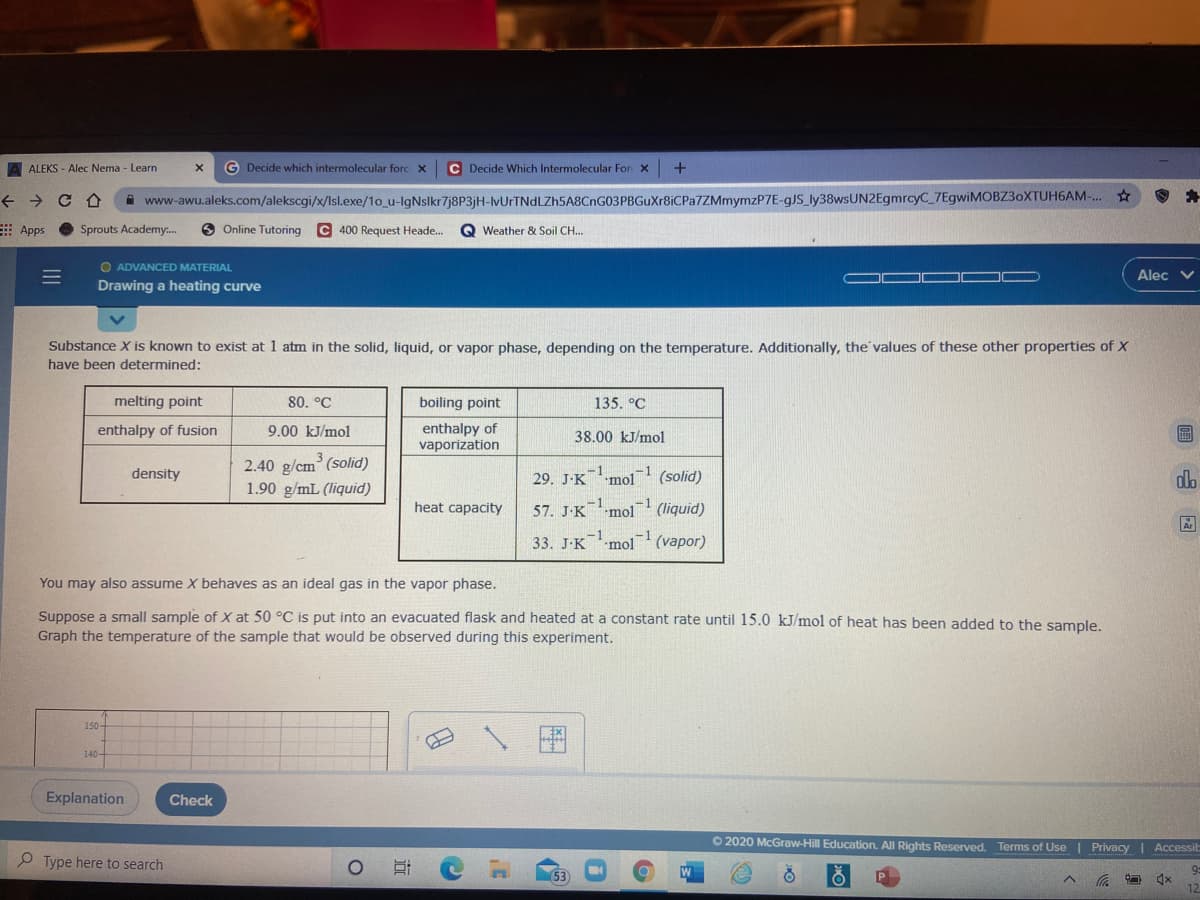Substance X is known to exist at 1 atm in the solid, liquid, or vapor phase, depending on the temperature. Additionally, the values of these other properties of X have been determined: melting point 80. °C boiling point 135. °C enthalpy of fusion enthalpy of vaporization 9.00 kJ/mol 38.00 kJ/mol 2.40 g/cm (solid) 1.90 g/mL (liquid) density 29. J-K mol (solid) heat capacity 57. J-Kmol (liquid) 33. J-Kmol (vapor) You may also assume X behaves as an ideal gas in the vapor phase. Suppose a small sample of X at 50 °C is put into an evacuated flask and heated at a constant rate until 15.0 kJ/mol of heat has been added to the sample. Graph the temperature of the sample that would be observed during this experiment.
Substance X is known to exist at 1 atm in the solid, liquid, or vapor phase, depending on the temperature. Additionally, the values of these other properties of X have been determined: melting point 80. °C boiling point 135. °C enthalpy of fusion enthalpy of vaporization 9.00 kJ/mol 38.00 kJ/mol 2.40 g/cm (solid) 1.90 g/mL (liquid) density 29. J-K mol (solid) heat capacity 57. J-Kmol (liquid) 33. J-Kmol (vapor) You may also assume X behaves as an ideal gas in the vapor phase. Suppose a small sample of X at 50 °C is put into an evacuated flask and heated at a constant rate until 15.0 kJ/mol of heat has been added to the sample. Graph the temperature of the sample that would be observed during this experiment.
Chemistry & Chemical Reactivity
9th Edition
ISBN:9781133949640
Author:John C. Kotz, Paul M. Treichel, John Townsend, David Treichel
Publisher:John C. Kotz, Paul M. Treichel, John Townsend, David Treichel
Chapter11: Intermolecular Forces And Liquids
Section: Chapter Questions
Problem 39IL
Related questions
Question

Transcribed Image Text:A ALEKS - Alec Nema - Learn
G Decide which intermolecular forc X
C Decide Which Intermolecular For x
i www-awu.aleks.com/alekscgi/x/Isl.exe/1o_u-lgNslkr7j8P3jH-IvUrTNdLZh5A8CnG03PBGuXr8iCPa7ZMmymzP7E-gJS ly38wsUN2EgmrcyC_7EgwiMOBZ3oXTUH6AM-.. ☆
Apps
Sprouts Academy.
O Online Tutoring
C 400 Request Heade.
Q Weather & Soil CH..
O ADVANCED MATERIAL
Alec v
Drawing a heating curve
Substance X is known to exist at 1 atm in the solid, liquid, or vapor phase, depending on the temperature. Additionally, the values of these other properties of X
have been determined:
melting point
80. °C
boiling point
135. °C
enthalpy of
vaporization
enthalpy of fusion
9.00 kJ/mol
38.00 kJ/mol
圖
2.40 g/cm
n³ (solid)
density
29. J-K.mo1
(solid)
1.90 g/mL (liquid)
heat capacity
57. J-K-1.
mol1 (liquid)
-1 (vapor)
33. J-K-1
•mol
You may also assume X behaves as an ideal gas in the vapor phase.
Suppose a small sample of X at 50 °C is put into an evacuated flask and heated at a constant rate until 15.0 kJ/mol of heat has been added to the sample.
Graph the temperature of the sample that would be observed during this experiment.
150-
图
140
Explanation
Check
O 2020 McGraw-Hill Education. All Rights Reserved. Terms of Use | Privacy | Accessit
P Type here to search
9:
Expert Solution
This question has been solved!
Explore an expertly crafted, step-by-step solution for a thorough understanding of key concepts.
This is a popular solution!
Trending now
This is a popular solution!
Step by step
Solved in 5 steps with 1 images

Knowledge Booster
Learn more about
Need a deep-dive on the concept behind this application? Look no further. Learn more about this topic, chemistry and related others by exploring similar questions and additional content below.Recommended textbooks for you

Chemistry & Chemical Reactivity
Chemistry
ISBN:
9781133949640
Author:
John C. Kotz, Paul M. Treichel, John Townsend, David Treichel
Publisher:
Cengage Learning

Chemistry & Chemical Reactivity
Chemistry
ISBN:
9781337399074
Author:
John C. Kotz, Paul M. Treichel, John Townsend, David Treichel
Publisher:
Cengage Learning

Chemistry for Engineering Students
Chemistry
ISBN:
9781337398909
Author:
Lawrence S. Brown, Tom Holme
Publisher:
Cengage Learning

Chemistry & Chemical Reactivity
Chemistry
ISBN:
9781133949640
Author:
John C. Kotz, Paul M. Treichel, John Townsend, David Treichel
Publisher:
Cengage Learning

Chemistry & Chemical Reactivity
Chemistry
ISBN:
9781337399074
Author:
John C. Kotz, Paul M. Treichel, John Townsend, David Treichel
Publisher:
Cengage Learning

Chemistry for Engineering Students
Chemistry
ISBN:
9781337398909
Author:
Lawrence S. Brown, Tom Holme
Publisher:
Cengage Learning